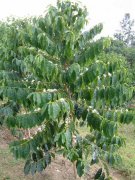Cultivation techniques of small Coffee cultivation of Coffee beans in Yunnan Province
Disease prevention and control:
The main results are as follows: 1. Coffee rust is the main disease of coffee, the most harmful, the damaged plants, the light ones reduce the yield, the heavy ones die. Coffee rust is mainly harmful to leaves and sometimes to young fruits and twigs. After the leaves were susceptible, many light yellow spots appeared at first, and expanded in the shape of water stains, and then there was a pile of orange-yellow powdery spores on the back of the leaves, and there was a light green halo around the disease spots. In the later stage, the disease spots gradually expanded or linked together, becoming irregular disease spots, and the disease spots finally withered, showing dark brown, and the whole susceptible leaves fell off.
Prevention and control methods:
② was planted with rust-resistant varieties. Quarantine work should be done strictly during introduction to prevent the spread of germs.
② strengthens tending management and improves plant disease resistance.
The pathogen was cleared by ③. The seedlings in the nursery should be inspected frequently to remove the diseased leaves; the plants in the coffee garden should be pruned to remove the weak branches and diseased leaves, especially before the end of the dry season, and all the diseased leaves should be removed immediately as soon as they are found. and combined with chemical control.
Chemical control of ④. Using 1% to 5% Bordeaux liquid spray, the first time should be before the rainy season, according to the specific situation and the severity and severity of the disease, generally every 2 to 3 weeks spray, rust Ning has a preventive effect on coffee disease, there is a therapeutic effect in the early stage of the disease. Use 25% wettable powder 35g / mu or 5% WP 150g / mu, spray 30kg of water.
2. Coffee anthracnose occurs in almost all coffee cultivated areas. It is mainly harmful to coffee leaves. After the initial infection of the leaves, there are light brown spots on the upper and lower surfaces, with a diameter of about 3 cm. The centers of these lesions are grayish white and turn completely gray in the later stage, with black dots arranged in concentric circles. Infection often begins at the edge of the leaf. The disease can spread to branches and fruits, causing branches to dry up; after the fruit is infected, there are sunken disease spots that turn black, and the flesh hardens and clings to the beans.

Important Notice :
前街咖啡 FrontStreet Coffee has moved to new addredd:
FrontStreet Coffee Address: 315,Donghua East Road,GuangZhou
Tel:020 38364473
- Prev

Coffee varieties more precious than Blue Mountain Coffee beans
Coffee name: Napoleon Origin: British St. Helena (Saint Helena Island, the claustrophobic island where the hero Napoleon was exiled) Farm: Napoleon Farm Variety: Bourbon Coffee name: blue Elise (Elise Blue) Origin: French New Caledonia (New Caledonia Island) Farm: Caf Kua
- Next

The process from Coffee Tree to Harvest the picking process of Coffee beans
The coffee tree is more than 3 meters tall. Coffee flowers white flowers, beautiful like magnolia, but life is short, it will wither after 3 days! After the coffee beans are in full bloom, the coffee beans turn from green to red and when the fruit is bright red and ripe, you can begin to pick and harvest the fruit, remove the skin, soak it in water for 12 to 16 hours, and then wash it. Remove the peel of coffee beans
Related
- Beginners will see the "Coffee pull flower" guide!
- What is the difference between ice blog purified milk and ordinary milk coffee?
- Why is the Philippines the largest producer of crops in Liberia?
- For coffee extraction, should the fine powder be retained?
- How does extracted espresso fill pressed powder? How much strength does it take to press the powder?
- How to make jasmine cold extract coffee? Is the jasmine + latte good?
- Will this little toy really make the coffee taste better? How does Lily Drip affect coffee extraction?
- Will the action of slapping the filter cup also affect coffee extraction?
- What's the difference between powder-to-water ratio and powder-to-liquid ratio?
- What is the Ethiopian local species? What does it have to do with Heirloom native species?

